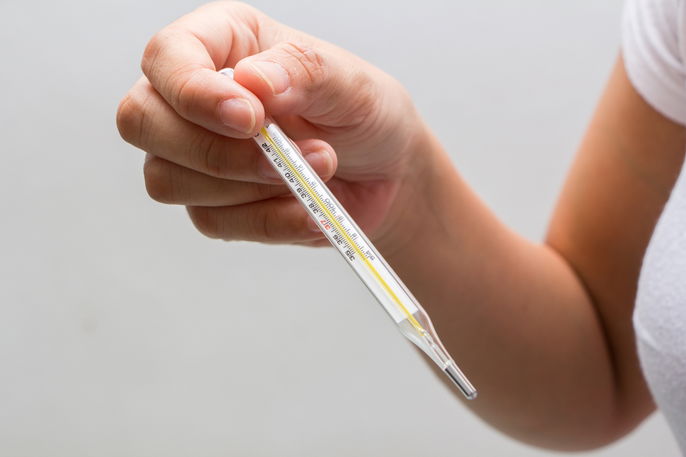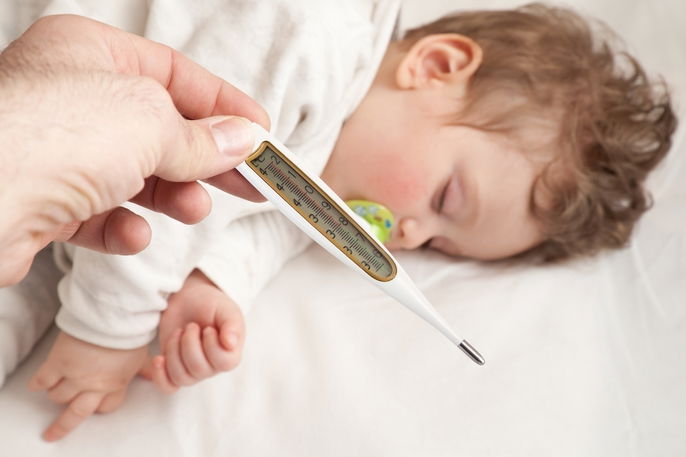Average body temperature can vary between 95.7ºF (35.4ºC) and 98.9ºF (37.2ºC), but a high temperature is only considered to be a fever when the temperature under the armpit (the axillary temperature) is higher than 100.4ºF (38ºC). This is because temperatures between 98.9 and 100.4ºF can be easily achieved when it’s very hot outside or when you have many layers of clothes on.
The most accurate way to determine whether you have a fever is by using a thermometer to measure your temperature. Placing a hand on the forehead or neck to assess whether a fever is present is not sufficient.
If your axillary temperature exceeds 102.2ºF (39ºC), you should seek medical attention, as a high fever can cause seizures or put your life in danger.

How to measure your temperature
Different types of thermometers require different methods for use. You should be familiar with how the thermometer works in order to get an accurate temperature reading. The most common types of thermometers are used in the following way:
- Glass or digital thermometer: place the metal tip into the armpit, anus or mouth in direct contact with the skin or the mucous membranes and wait for at least 3 minutes, or until the thermometer makes a sound before you check your temperature;
- Infrared thermometer: place the tip of the thermometer on your forehead or inside the ear canal and press the button. After the beep, the temperature will come up on the thermometer immediately.
Body temperature should be measured at rest. You should not check your temperature after exercising or after a shower or bath as these situations will cause a temporary increase in temperature, and will not provide an accurate reading of actual body temperature.
Digital thermometers are the most comfortable and accurate thermometers to use in adults. However, any thermometer is trustworthy, as long as it is used correctly. The only type of thermometer we do not advise is the mercury thermometer, as it can cause poisoning if it breaks.
How to measure a baby’s temperature
A baby’s body temperature should be measured with a thermometer, as fever can be hard to detect with just palpation. Digital or infrared thermometers are quick and most accurate for use in babies.
The best place to measure the baby’s temperature correctly is the anus, and it is best to use a digital thermometer with a soft tip to avoid injury. However, if the parents do not feel comfortable with this, they may measure the temperature in the armpit and confirm that temperature with the anal temperature at the pediatrician’s office. Learn about how to care for a baby with a fever.
What is considered a fever in adults?
A normal body temperature, measured with an axillary thermometer, varies between 95.7ºF (35.4ºC) and 98.9ºF (37.2ºC), but this can increase when with an infection that causes fever. The main body temperature variations are:
- Low-grade fever: Between 99.5ºF (37.5ºC) and 100.4ºF (38ºC). In these cases, generally, other symptoms may appear, such as shivering, shaking, or facial redness. Many times, you can resolve this increase in temperature by removing a layer of clothing, by taking a warm bath or by drinking water;
- Fever: When the axillary temperature is above 100.4ºF (38ºC). In adults, it can be treated with acetaminophen and by ensuring you are only wearing one later of clothing. You can also place cold compresses on the forehead. If the temperature does not resolve, even slightly, within three hours or if it continues to rise, you are advised to seek medical attention.
- High-grade fever: this is when the axillary temperature is above 105.8ºF (41ºC), which is considered to be a medical emergency. You should be assessed as soon as possible, especially if it does not resolve at home with medication.
Your body temperature may also be below usual if it is under 95.7ºF (35.4ºC). This generally happens when you are exposed to cold temperatures for a long time, also known as hypothermia. In these cases, you will need to remove yourself from the cold envronment, put on several layers of clothing, and drink warm fluids like tea.

What is considered a fever in babies and children?
Babies and children have a slightly different body temperature to adults, as it usually varies between 96.8ºF (36ºC) and 98.6ºF (37ºC). The main temperature variations in children are:
- Low-grade fever: between 98.8ºF (37.1ºC) and 99.5ºF (37.5ºC). In these cases, remove a layer of clothing and give the child a bath in lukewarm water;
- Fever: A rectal temperature above 100.04ºF (37.8ºC) or axillary temperature above 100.4ºF (38ºC). In these cases, the caregivers should consult a health care professional about starting over-the-counter medication and to assess whether they need to go to the emergency department;
- Low body temperature (hypothermia): temperature below 95.9ºF (35.5ºC). In these cases, make sure to put on another layer of clothes on the child and avoid cold drafts. If the body temperature does not increase within 30 minutes, go to the emergency department.
Fluctuations in babies’ and children’s body temperatures are not always due to illness or infection, as the body temperature may vary according to the number of clothes worn, teeth erupting, a reaction to a vaccine, or due to a hot of environment.
When should you to take medication
Removing extra clothing and taking a warm bath are good ways to lower body temperature. Still, when this is not sufficient, the doctor may recommend you take an antipyretic to reduce the fever. The medication most people take in these situations is acetaminophen. Frequency or how many capsules you take vary on the dose of each pill, but you should not exceed 4000mg in 24 hours.
Babies and children should only take medication for fever under medical supervision as dosing will vary according to age and weight.






























